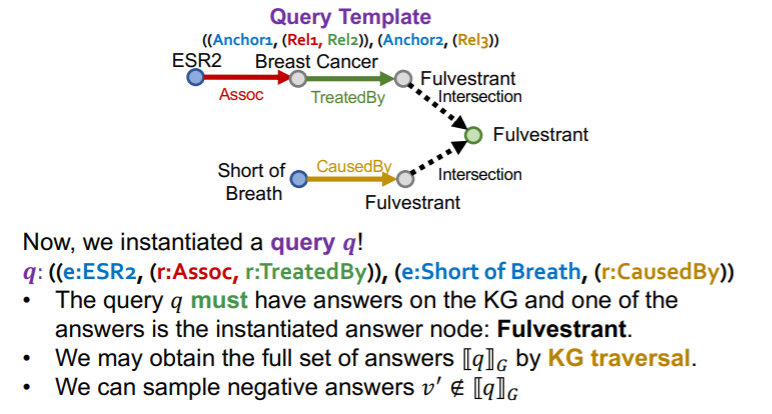[ 11. Reasoning over Knowledge Graphs ]
( 참고 : CS224W: Machine Learning with Graphs )
Contents
- Review
- 11-1. Reasoning in KG
- 11-2. Answering Predictive Queries
- 11-3. Query2Box
Review
Knowledge Graph (KG) Completion
-
H : head / R : relation / T :tail
-
goal : given (H,R), predict T
-
example )
- H : “J.K.Rowling”
- R : “genre”
- T: “Science Fiction”

11-1. Reasoning in KG
Question : how to perform “MULTI-hop” reasoning over KGs?
Reasoning over KG
- Answering multi-hop queries
- Path queries
- Conjunctive queries
- Query2Box
Task : how to do multi-hop reasoning ( = complex queries ), on “incomplete, massive” KG?
Types of Queries
(a) One-Hop queries
(b) Path queries
(c) Conjunctive queries

(a) Predictive one-hop queries
KG completion \(\approx\) one-hop queries
- KG completion : is link \((h,r,t)\) in KG?
- One-hop query : is \(t\) the answer to query \((h,r)\) ?
(b) Path queries
- generalization of one-hop queries
- add more relations on the path
- ex) \(n\)-hop path query :
- \(q = (v_a, (r_1, \cdots r_n))\).
- \(v_a\) : anchor entity
- answer = \([[q]]_G\)

Example : “What proteins are associated with adverse events caused by Fulvestrant?”
- ( anchor entity )
- \(v_a\) = e : Fulvestrant
- ( relation )
- \((r_1, r_2)\) = (r : Cause, r : Associate)
- ( query )
- ( e: Fulvestrant, ( r : Cause, r : Associate ) )

How to answer? traverse in the KG…!?

Problem : KGs are INCOMPLETE! ( = many relations are missing! )
Then, how about…
- (step 1) KG completion
- (step 2) traverse..?
\(\rightarrow\) NO! completed KG is a “dense graph” ( time complexity problem )
Solution : Predictive Queries
\(\rightarrow\) Implicitly impute and account for the incomplete KG
- can answer without KG completion!
- generalization of “link prediction”
11-2. Answering Predictive Queries on KGs
Key idea : Embed queries
- generalize TransE to “multi-hop” reasoning
- ( TransE ) score function : \(f_{r}(h, t)=- \mid \mid \mathbf{h}+\mathbf{r}-\mathbf{t} \mid \mid\)
- ( TransE ) Reinterpretation
- query embedding : \(\mathbf{q}=\mathbf{h}+\mathbf{r}\)
- (before) \(f_{r}(h, t)=- \mid \mid \mathbf{h}+\mathbf{r}-\mathbf{t} \mid \mid\)
- (after) \(f_{q}(t)=- \mid \mid \mathbf{q}-\mathbf{t} \mid \mid\)


- Query Embedding : just “vector addition”
Example :

Traversing KG in vector space
- TransE : can handle composition relations
- TransR, DistMult, ComlEx : cannot ~
Conjunctive Queries
how about queries with “logic conjunction” operation?
- ex) “What are drugs that cause Short of Breath AND treat diseases associated with protein ESR2?”


Traverse KG from “2 anchor nodes”

Problem : what is certain link is missing…?

\(\rightarrow\) we have to “implicitly” impute it!
Key point :
- 1) How to make “intermediate node representation”?
- 2) How to define “intersection operation” in latent space?
11-3. Query2Box
Box Embeddings
embed queries with “BOXES”
- \(\mathbf{q}=(\operatorname{Center}(q), \text{Offset}(q))\).
- why? can easily define “intersection of boxes”
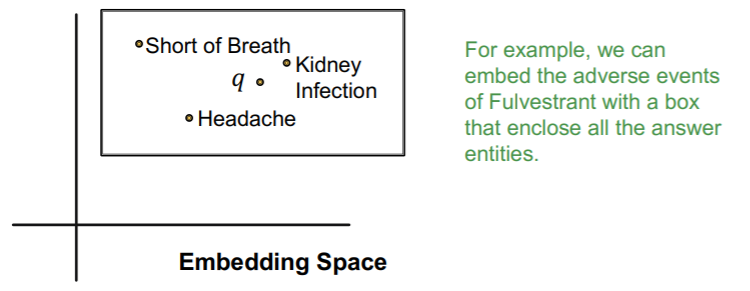
Need to figure out…
- 1) Entity embeddings ( # of params : \(d \mid V \mid\) )
- 2) Relation embeddings ( # of params : \(2 \mid R \mid\) )
- 3) Intersection operator \(f\)
Projection Operator, \(\mathcal{P}\)
- input : box
- projection & expansion : with Relation embedding
- output : box
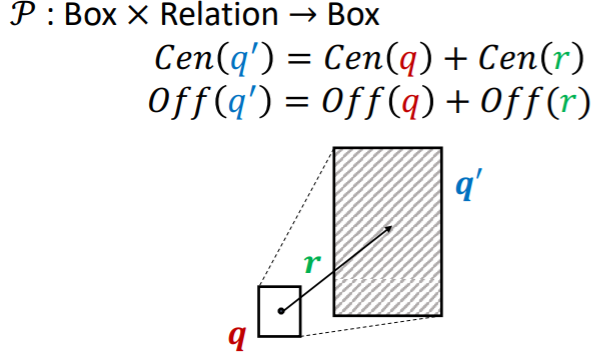
Example :

Intersection Operator, \(\mathcal{J}\)
- input : multiple boxes
- output : intersection box
- key point
- center of new box : weighted average of boxes
- size of new box : shrink

[ a) Center ]

- \(w_i\) : “self-attention” score for each center of each input
- \(f_\text{cen}\) : NN
[ b) Offset ]

- \(\sigma\) : sigmoid ( 0 ~ 1 )
- \(f_\text{off}\) : NN
Entity-to-Box distance
Score function \(f_q(v)\) ( = negative distance )
- inverse distance of “node \(v\)” as answer to \(q\)
- notation
- \(\mathbf{q}\) : query box
- \(\mathbf{v}\) : entity embedding ( box )
- \(f_q(v) = -d_{\text {box }}(\mathbf{q}, \mathbf{v})\).
- \(d_{\text {box }}(\mathbf{q}, \mathbf{v})=d_{\text {out }}(\mathbf{q}, \mathbf{v})+\alpha \cdot d_{\text {in }}(\mathbf{q}, \mathbf{v})\),
- where \(0<\alpha<1\).
- if “inside the box”, “distance should be DOWNweighted”
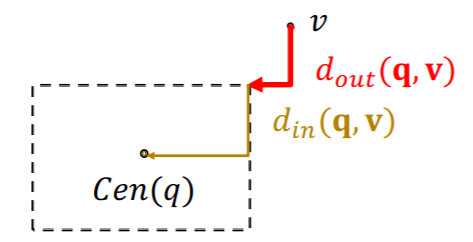
Union Operation (OR)
-
EPFO (Existential Positive First-Order) queries
= conjunctive queries + disjunction
= AND-OR queries
-
union over arbitrary queries \(\rightarrow\) TOO high dim
then…how to handle them?
Key idea :
- step 1) take all unions out
- step 2) do union only at the LAST STEP
\(\rightarrow\) Disjunctive Normal Form (DNF)

Disjunctive Normal Form (DNF)
\(q=q_{1} \vee q_{2} \vee \cdots \vee q_{m}\).
- \(q_i\) : conjunctive query
Process
-
step 1) embed all \(q_i\)
-
step 2) “aggregate at LAST step”
Distance between
- 1) entity embedding \(\mathbf{v}\)
- 2) DNF \(\mathbf{q}\)
\(\rightarrow\) \(d_{b o x}(\mathbf{q}, \mathbf{v})=\min \left(d_{b o x}\left(\mathbf{q}_{1}, \mathbf{v}\right), \ldots, d_{b o x}\left(\mathbf{q}_{m}, \mathbf{v}\right)\right)\)
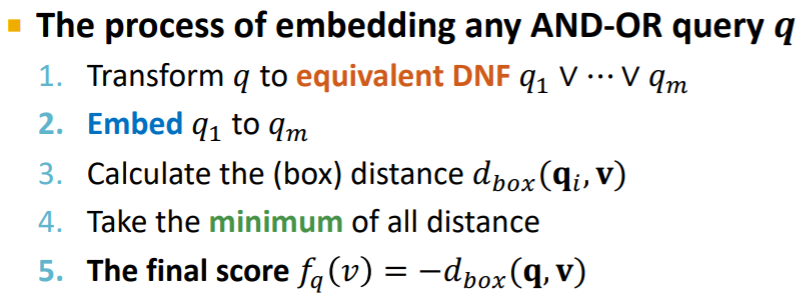
Training Overview
Intuition : given query embedding \(\mathbf{q}\)…
- maximize \(f_q(v)\) for \(v \in [[q]]\)
- minimize \(f_q(v')\) for \(v \notin [[q]]\)
Parameters :
- 1) Entity embeddings ( # of params : \(d \mid V \mid\) )
- 2) Relation embeddings ( # of params : \(2 \mid R \mid\) )
- 3) Intersection operator \(f\)
Training Procedure

So, how to generate dataset?
( = how to generate queries, from multiple query templates? )
-
query templates :

-
how to instantiate a query template?
- Start from instantiating the answer node of the query template, and then iteratively instantiate the other edges and nodes until we ground all the anchor nodes
